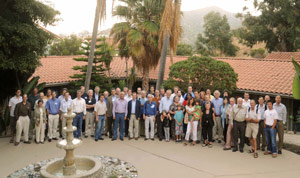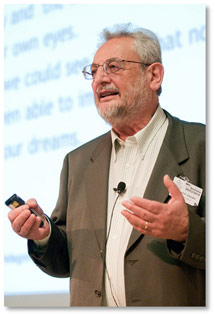
Handy Links
SLAC News Center
SLAC Today
- Subscribe
- Archives: Feb 2006-May 20, 2011
- Archives: May 23, 2011 and later
- Submit Feedback or Story Ideas
- About SLAC Today
SLAC News
Lab News
- Interactions
- Lightsources.org
- ILC NewsLine
- Int'l Science Grid This Week
- Fermilab Today
- Berkeley Lab News
- @brookhaven TODAY
- DOE Pulse
- CERN Courier
- DESY inForm
- US / LHC
SLAC Links
- Emergency
- Safety
- Policy Repository
- Site Entry Form

- Site Maps
- M & O Review
- Computing Status & Calendar
- SLAC Colloquium
- SLACspeak
- SLACspace
- SLAC Logo
- Café Menu
- Flea Market
- Web E-mail
- Marguerite Shuttle
- Discount Commuter Passes
-
Award Reporting Form
- SPIRES
- SciDoc
- Activity Groups
- Library
Stanford
Around the Bay
Fifth Generation Lightsource Workshop Honors LCLS Pioneer
The dedication of the Linac Coherent Light Source is less than two months in the past, but the free-electron laser community is already actively planning for the future, as demonstrated by "Towards a Fifth Generation Light Source," a two-day workshop held on Santa Catalina Island last weekend. The workshop drew a sizable crowd of SLAC and SLAC-affiliated scientists, who made up almost half of the more than 50 attendees. They gathered for two purposes: to discuss possible future directions for fifth-generation lightsources, and to honor one of the key people responsible for the only fourth-generation hard X-ray free electron laser, or FEL, currently in operation—physicist Claudio Pellegrini, who played a vital role in the development and construction of the LCLS and who is retiring from the University of California, Los Angeles at the end of this year.
Pellegrini himself opened the workshop with "What is a Fifth Generation Light Source?"
The workshop "was an open conversation about what a fifth-generation lightsource is," said SLAC accelerator physicist Paul Emma. He ticked off some nascent requirements that made up the group's wish list: stronger, shorter laser pulses with a higher peak brightness, improved undulators that enable control of the beam's polarization, and "multi-bunch operation," in which each radio-frequency pulse used to accelerate electrons can speed up multiple bunches of electrons instead of only one.
As Pellegrini pointed out in his presentation, "It is likely that different FELs will be needed to fully satisfy all the [wish list] requests."
But to build these FELs most cost-effectively, physicists need to shrink the accelerators that power the X-ray-generating electrons. As SLAC physicist and long-time LCLS booster Herman Winick explained, the growing importance of lightsources to research makes FELs quite attractive, but cost is a significant obstacle. "Everyone wants one," Winick said, "but if an FEL will cost $420 million plus a one-kilometer linac to power it, they can't do it."
Several presenters discussed alternative accelerator technologies that could shorten a linac. Some, like plasma wakefield acceleration and laser acceleration, are currently being investigated at SLAC.
After all the discussions of short-period undulators, inverse Compton scattering and laser-driven dielectric accelerators, among other topics, the workshop attendees got down to the serious business of celebrating the life and career of Claudio Pellegrini.
"I enjoyed Claudio's symposium very much," said Zhirong Huang, from the FEL Physics group at SLAC. "It gave me a good historical perspective of his scientific achievements and on the conception of the LCLS." This history stretches back at least 35 years.
"Claudio developed some of the most important FEL theory in 1984," Emma said.
But 1992 was the seminal year for the LCLS, as Winick explained. That was the year Pellegrini "made the first suggestion for the X-ray laser that's revitalizing SLAC." He did so at a February 1992 "Workshop on Fourth Generation Light Sources," organized at SLAC by Winick and Massimo Cornacchia.
Winick heard Pellegrini's suggestion and was so taken with it that less than a month later he organized the first of a series of discussions to explore the idea further. Pellegrini attended. These monthly meetings continued for a decade, Winick said.
"He was involved in all of it," Winick said. "The RF photocathode gun, the compressors, the undulators. All of it."
The project drew the attention of other accelerator scientists, many also not from SLAC, who donated time and effort during the 10 years before the LCLS attracted funding, Winick said. He attributes that to SLAC's unique situation.
"No one else had a linac like SLAC," he said, to provide the electrons that would generate coherent X-ray pulses. "We saw that an X-ray laser could be made out of the linac and we just worked on it. It was challenging; it was fun." And Pellegrini was there throughout.
"It's rare that so much of the genesis and initial development of a project can be attributed to one person," Winick said, but the LCLS is an exception. "The success of the laser is a tribute to his ideas and his leadership."
—Lori Ann White
SLAC Today, October 8, 2010

